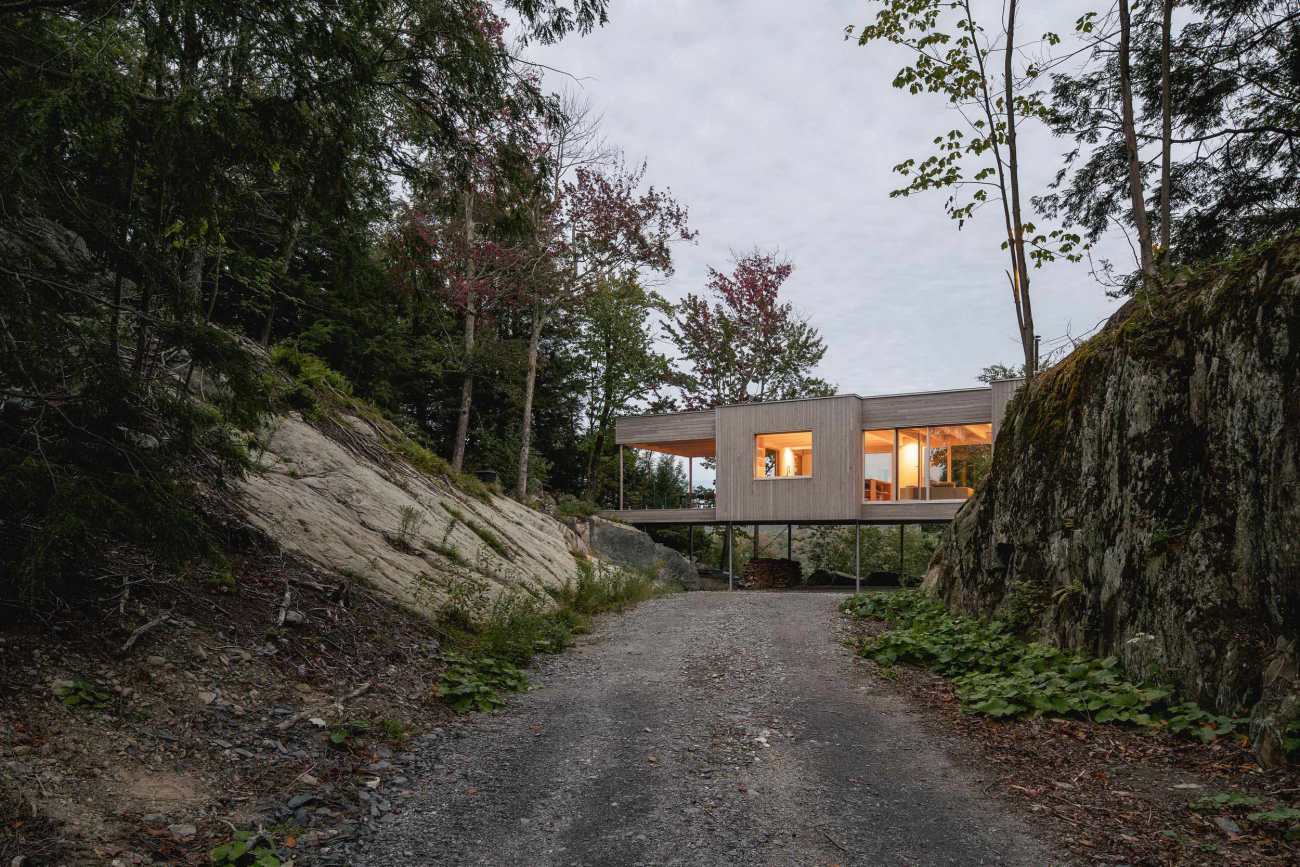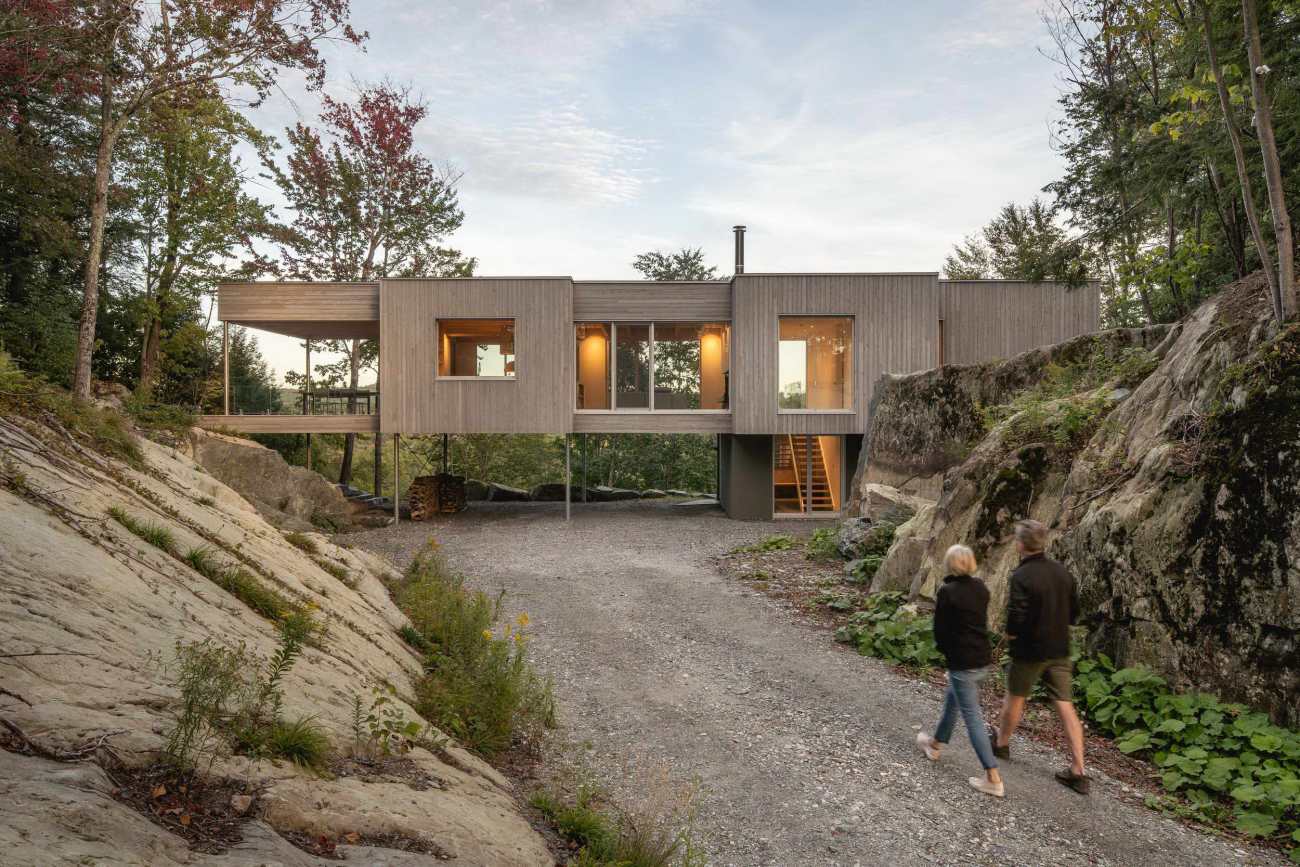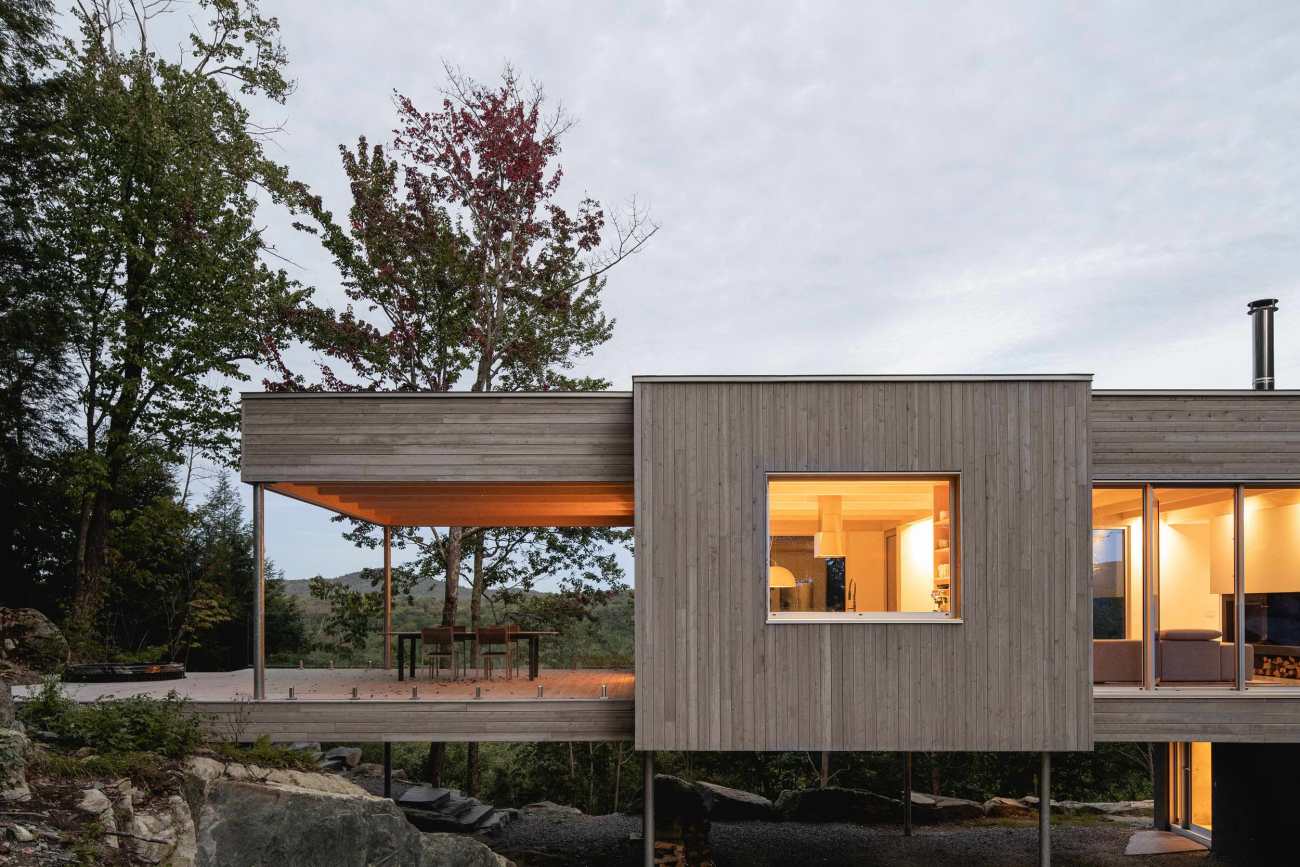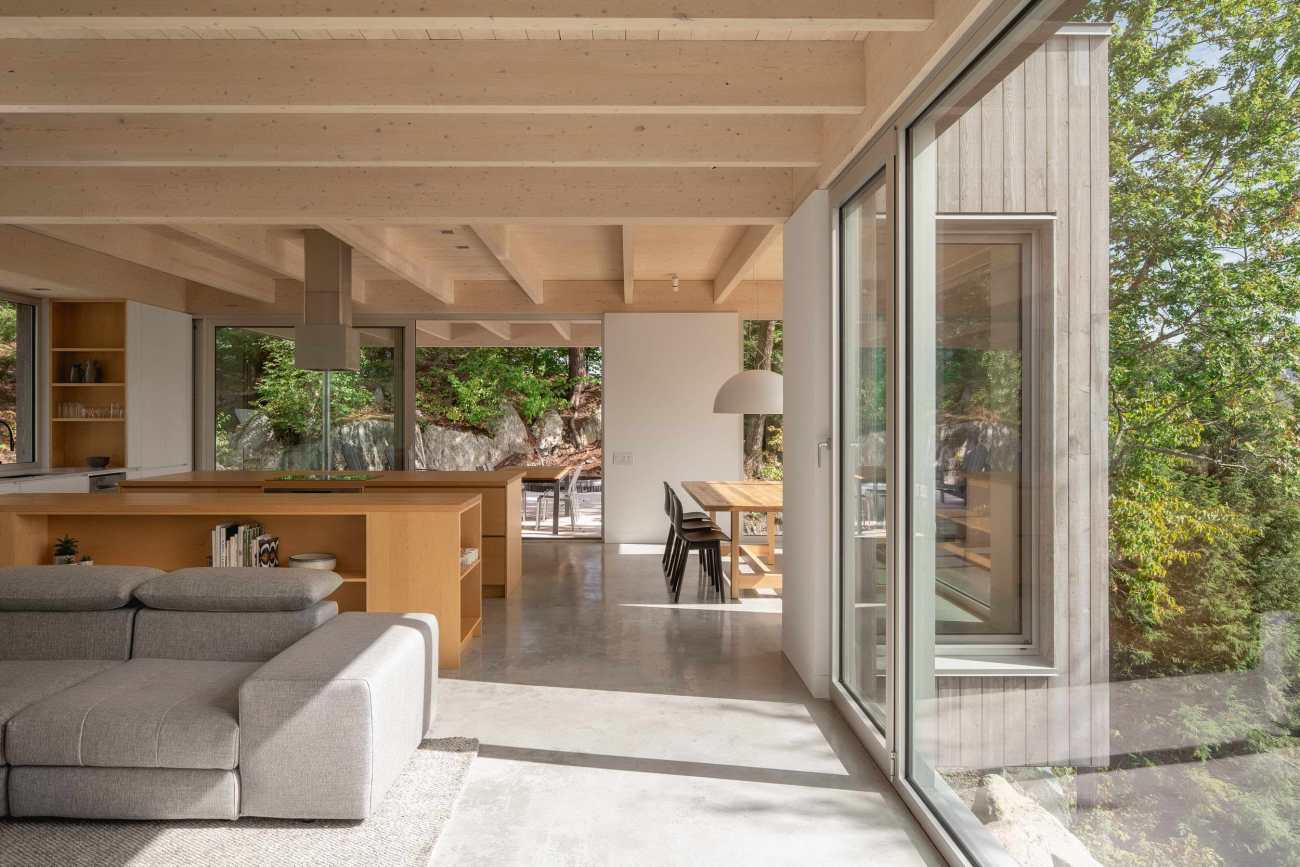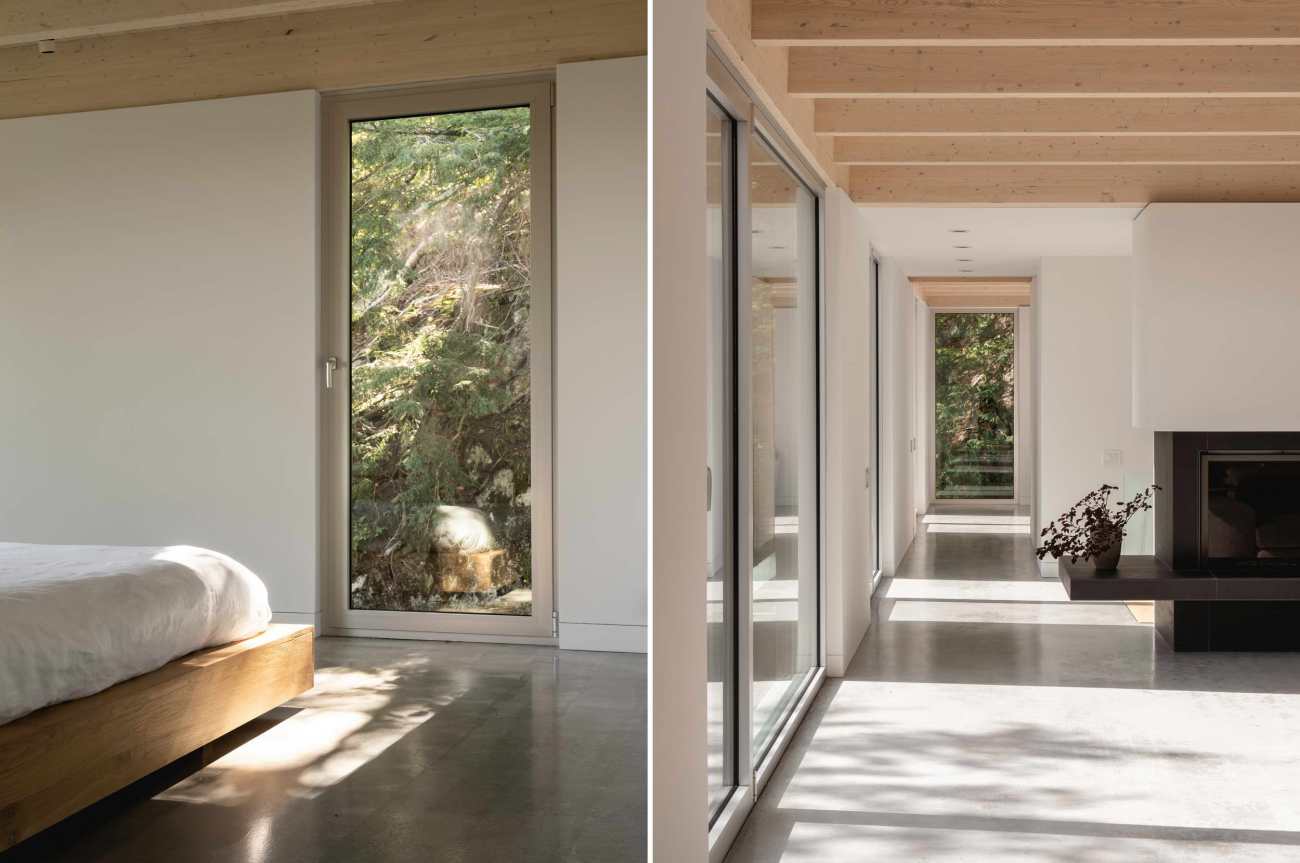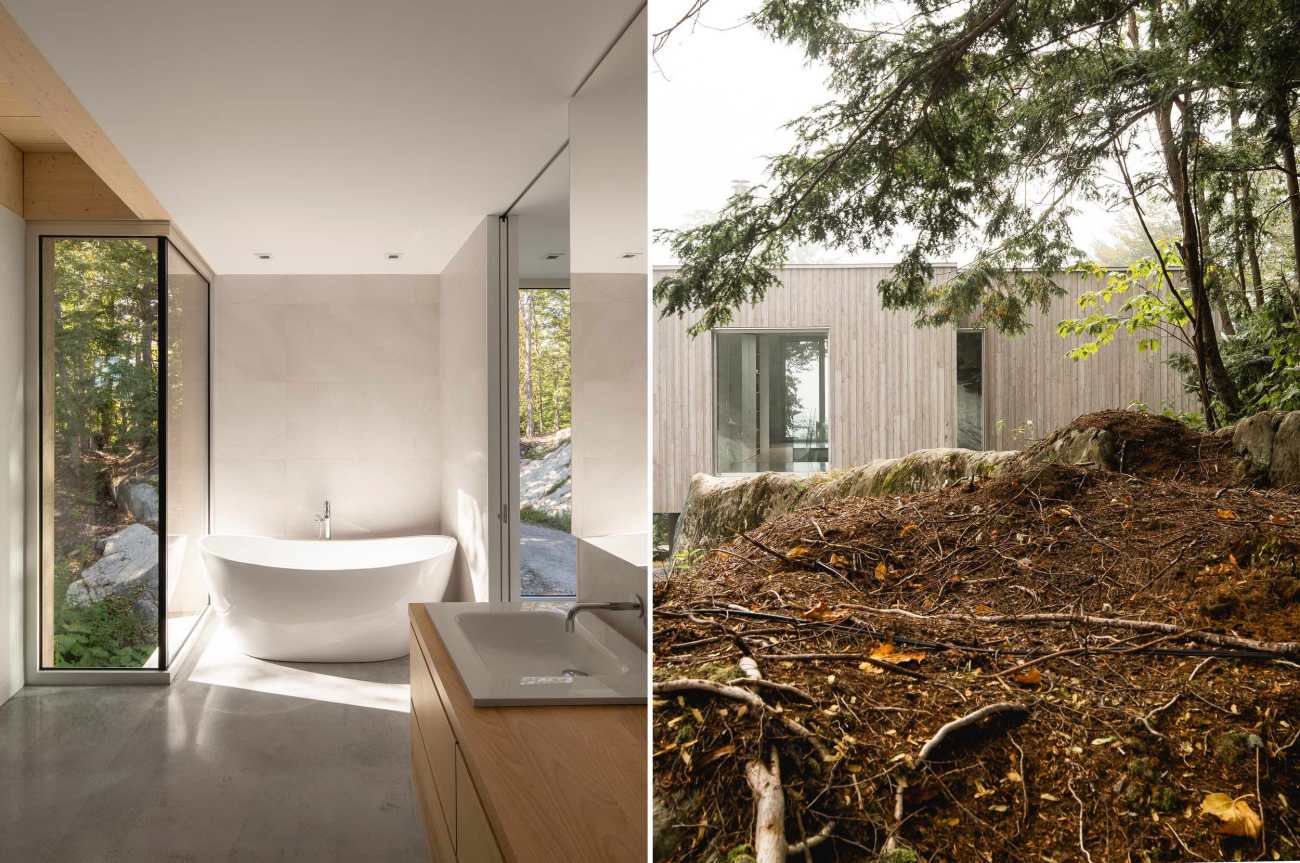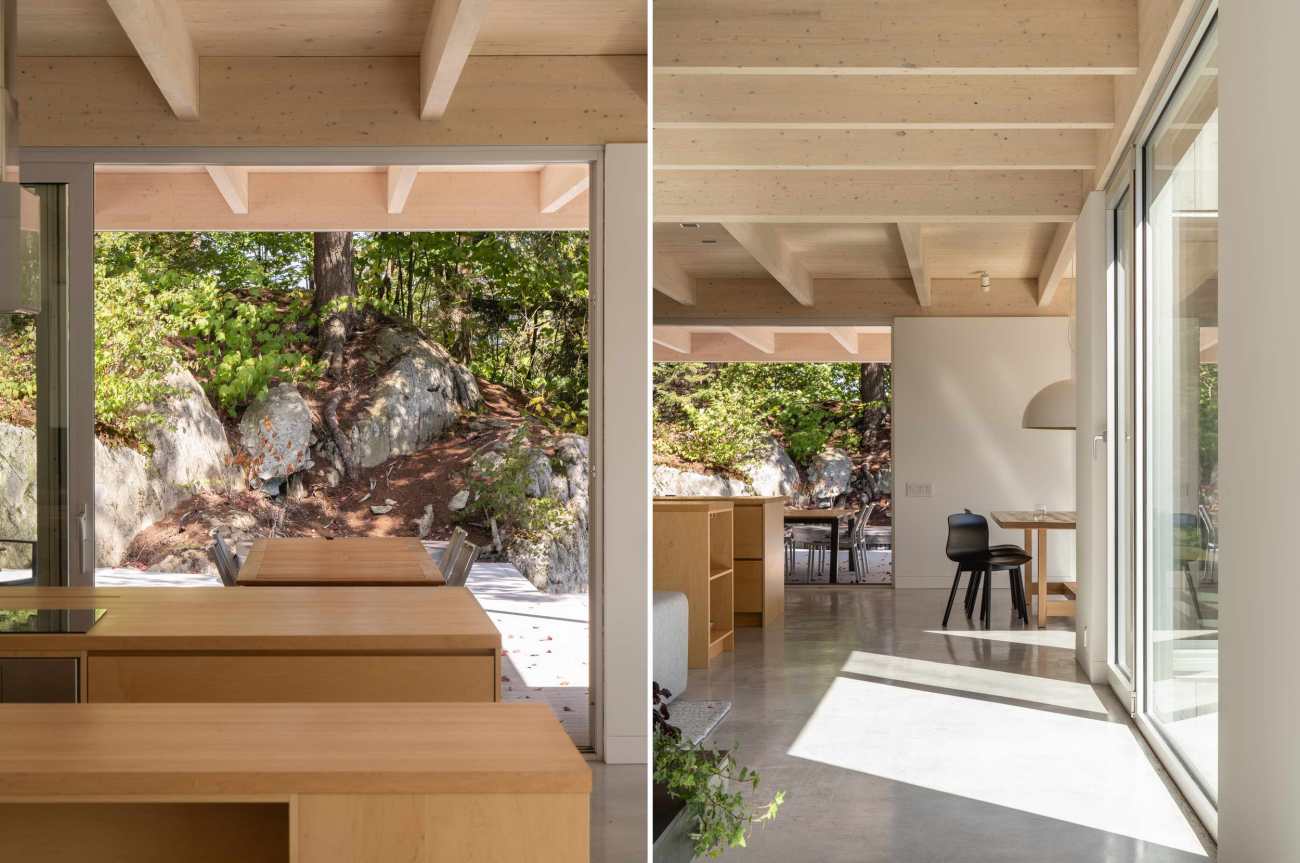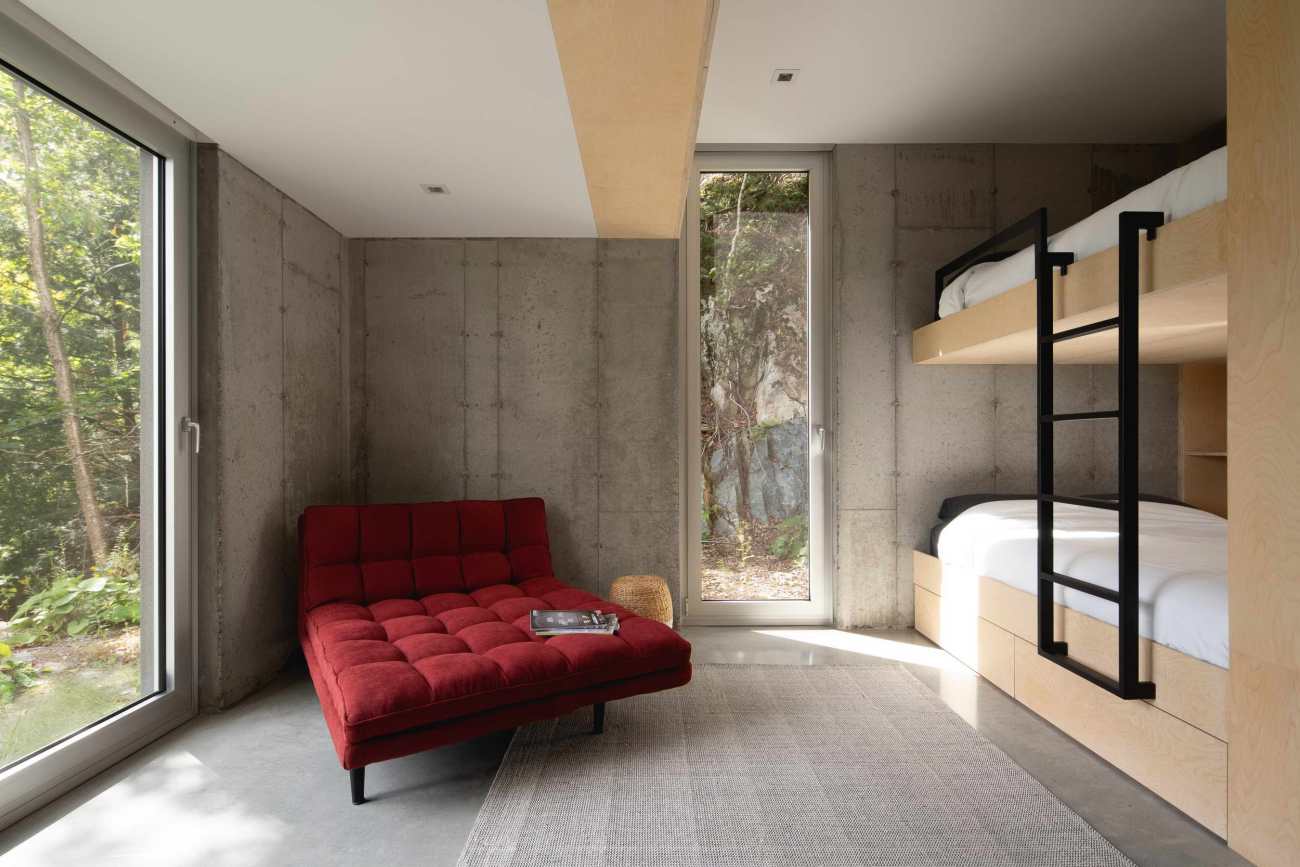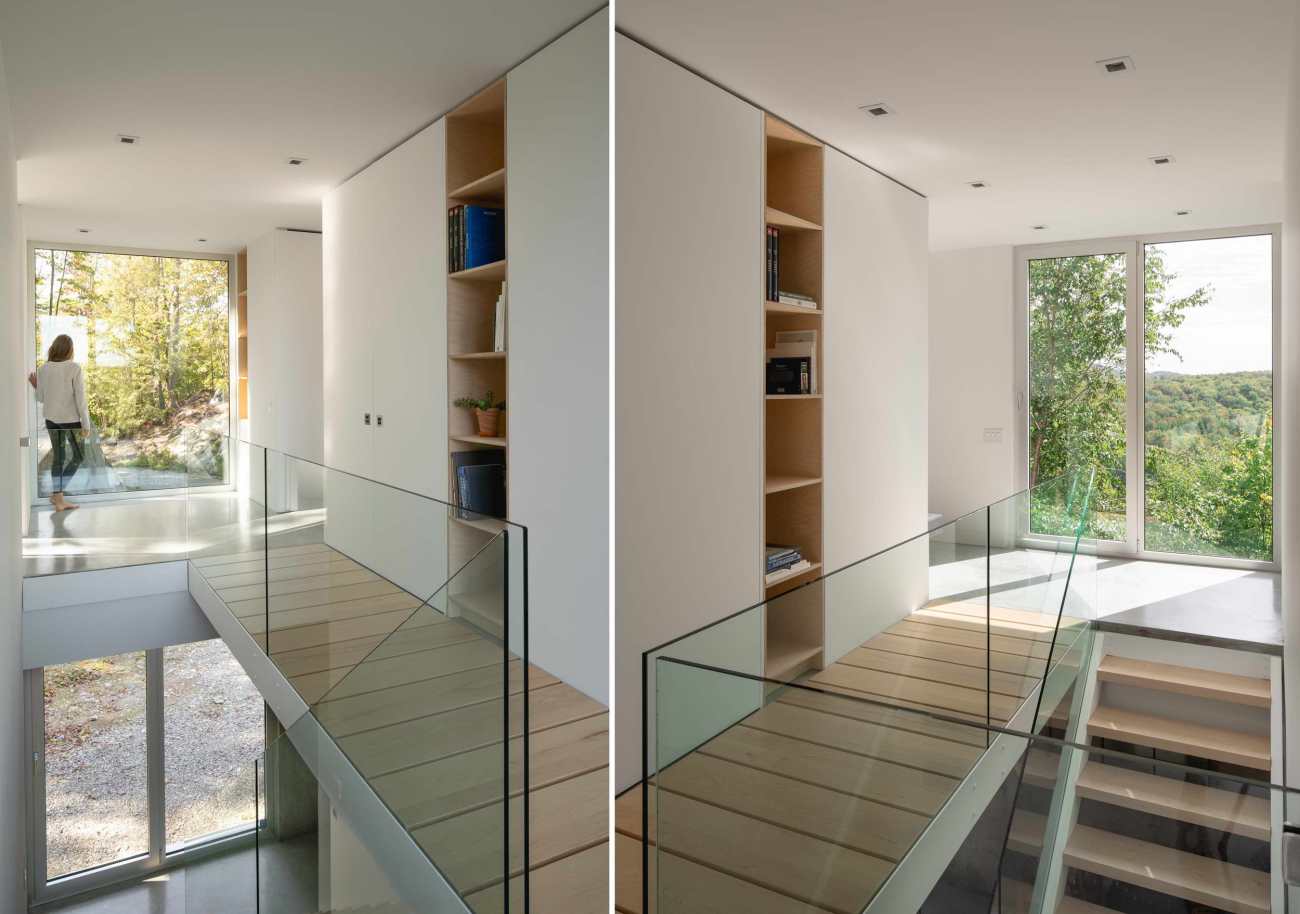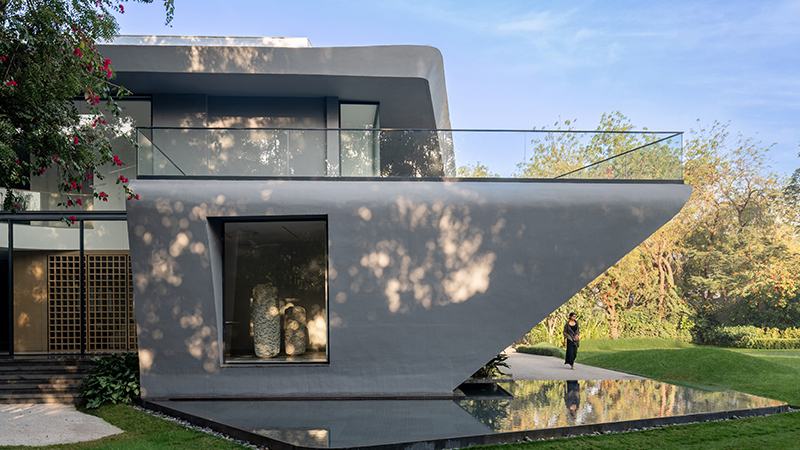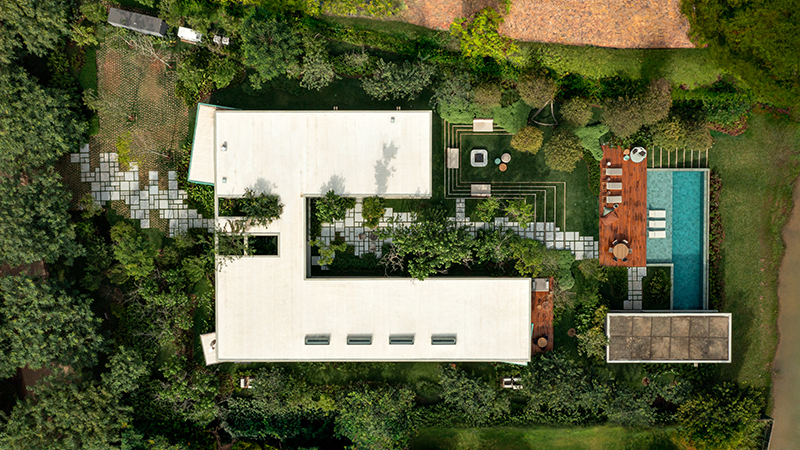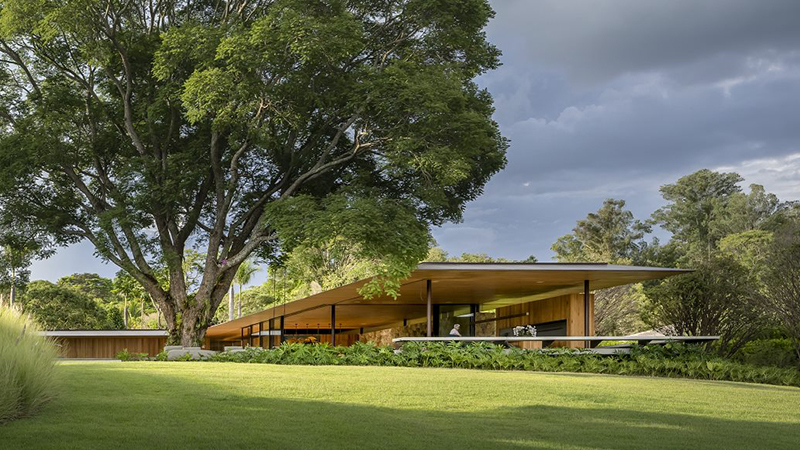| 公司: | Natalie Dionne Architecture | 类型: | 建筑 |
|---|---|---|---|
| 地区: | 加拿大 | 标签: | 别墅私宅 |
Forest House I是蒙特利尔工作室Natalie Dionne Architecture的最新作品。多年来,该公司因其因地制宜的方法、创造力和对细节的关注赢得了广泛的赞誉。Forest House I为公司丰富的原创住宅组合增添了新的内容,兼具城市和乡村的特点。占地三英亩,位于东部乡镇,距离蒙特利尔东南约100公里。该地区因其自然美景和相对靠近城市生活而受到城市居民的极大重视,现在已经成为愿意并能够在家工作的人的选择之地。客户是一对职业夫妇,长期以来一直梦想着在大自然的中心地带为自己建造一个家。这座住宅巧妙地嵌入地形中,周围是成熟的铁杉和落叶树,旨在向活生生的森林致敬。室内外的材料都以木材为主。 过早老化的木板覆面、裸露的框架以及其他各种室内饰面,都展示了天然材料的丰富性。
Forest House I is the latest work by Montréal-based studio, Natalie Dionne Architecture. The firm has earned widespread praise over the years for its contextual approach, its creativity, and its attention to detail. Forest House I adds to a rich portfolio of original, residential homes, equal parts urban and rural. The three-acre site, located in the Eastern Townships, is roughly 100 kilometers southeast of Montreal. Greatly valued by city dwellers for its natural beauty and relative proximity to urban life, the area has now become a choice spot for those willing and able to work from home. The clients, a professional couple, had long cherished the dream of building themselves a home in the heart of nature. Discreetly inserted onto an outcrop of the Canadian shield, surrounded by mature hemlock and deciduous trees, the home is meant to pay tribute to the living forest. Wood dominates a restrained palette of materials, both inside and outside. The prematurely aged plank cladding, exposed framework, and various other interior finishes showcase all the richness of the natural material.
策略性的嵌入场地
现有地形中的天然裂缝、不理想的朝向以及众多岩石的存在,都给客户和建筑师带来了巨大的挑战。在仔细而彻底的 "走访现场"过程中,悬崖附近一块特别不切实际的岩层引起了他们的注意,并为如何放置住宅提供了灵感和见解。站在3米高的岩石上,各方都认为,为了最大限度地利用现有的光线和景观,与山脊平行的居住区必须抬高到这个高度,并伸过碗状物,以便在北面的岩石上软着陆,在那里找到最好的光线。抬高的结构,最小化的占地面积,优先考虑对现有地形的低影响,还可以通过强调和确保悬崖之外的壮丽景观,创造一个戏剧性的住宅方式。
Strategic implantation
A natural cleft in the existing topography, suboptimal orientation, and the presence of numerous rocky outcrops presented a major challenge for both clients and architects. During a careful and thorough ‘walking of the site,’ a particularly impractical rock formation near a precipice caught their eye and provided inspiration and insight as to how to place the home. Standing on top of the 3m tall rock, all parties agreed that, in order to get the most out of available light and views, the living quarters, set parallel to the ridge, had to be jacked up to this level and reach out across and over the bowl in order to make a soft landing on the rocky outcrop to the north where the best light was to be found. An elevated structure, on a minimalist footprint, prioritizing a low impact intervention to the existing terrain, was also understood to have the added benefit of creating a dramatic approach to the home by emphasizing, and assuring the persistence of, the magnificent vista that lay beyond the precipice.
建筑方案
主层是项目的核心(位于一端,在一块孤石曾经矗立过的基座上),悬停在岩石裂缝上,向北面被苔藓覆盖的悬崖投射出一个广阔的、户外的、部分覆盖的露台。从这个外部的栖息地,专门用于放松和户外生活的嵌入式水疗和休闲家具,人们通过这个线性建筑南端的厨房、餐厅、起居室和夫妇的卧室套房等流动的内部空间。楼梯和门厅与住宅地面的主入口大厅相通,插入客厅和卧室之间。毗邻入口大厅,我们发现,一个双层房间,能够容纳多达10名客人。
The architectural program
The main floor, the heart of the project (anchored at one end, atop a base where a lonely rock once stood) hovers over the rocky cleft and projects a vast, outdoor, partially covered terrace towards a moss-covered escarpment to the north. From this exterior perch, dedicated to relaxation and outdoor living with its embedded spa and leisure furniture, one passes to the fluid interior spaces of the kitchen, dining room, living room, and the couple's bedroom suite at the southern end of this linear building. The staircase and foyer, which communicates with the home’s main entrance hall at ground level, are inserted between the living room and the bedroom. Adjacent to the entrance hall, we find, a bunkroom, capable of accommodating up to 10 guests.
起居室两边的地板到天花板都是玻璃,沐浴在自然光中。在东面,一个戏剧性的坡度暴露了森林树冠的壮观景色。从外墙伸出的几个凹槽,为厨房、用餐区和主浴室提供了额外的空间,并提供了额外的景观和阳光从南部穿透。
The sitting area, glazed floor to ceiling on both sides, is bathed in natural light. To the east, a dramatic incline exposes a spectacular view of the forest canopy. Several alcoves, projecting out from the façades, grant extra space to the kitchen, dining area, and master bathroom and provide additional views and sunlight to penetrate from the south.
主人套房是主层唯一的私人空间,也有全高的窗户。其中一扇窗户被放置在主要的流通轴线上,直接面对着一个外露的地方。 其效果是,从房子的一端到另一端完全透明。在西侧,精心设计的浴室是一个完美的沉思场所,它的浴缸插在一个带玻璃的角落凹槽里。
The master suite, the only private space on the main level, features full-height windows as well. One of these was placed along the main circulation axis, directly in front of an outcrop. The effect is one of total transparency from one end of the house to the other. On the west side, the carefully designed bathroom features a perfect spot for contemplation with its bathtub inserted in a glassed-in corner alcove.
材料和色彩搭配
在这个215平方米的住宅中,木头随处可见,它力求与周围环境共生。外露的屋顶结构是由北魁北克黑云杉制成的工程木材。这些支撑屋顶规则网格的结构元素的设计和细节受到了特别关注。由东部白雪松覆盖的外墙,用一种加速灰化过程的产品进行了预处理,以便像变色龙在岩石上晒太阳一样融入景观,并使未来的维护工作降到最低。
Materials and color palette
Wood is everywhere present in this 215 sq m home, which strives towards symbiosis with the surrounding environment. The exposed roof structure is made of engineered wood produced from Northern Québec black spruce. Particular attention was paid to the design and detailing of these structural elements supporting the roof’s regular grid. The façades, clad in eastern white cedar, were pretreated with a product accelerating the greying process, so as to blend into the landscape like a chameleon sunning itself on a rock, and to keep future maintenance to a minimum.
 | 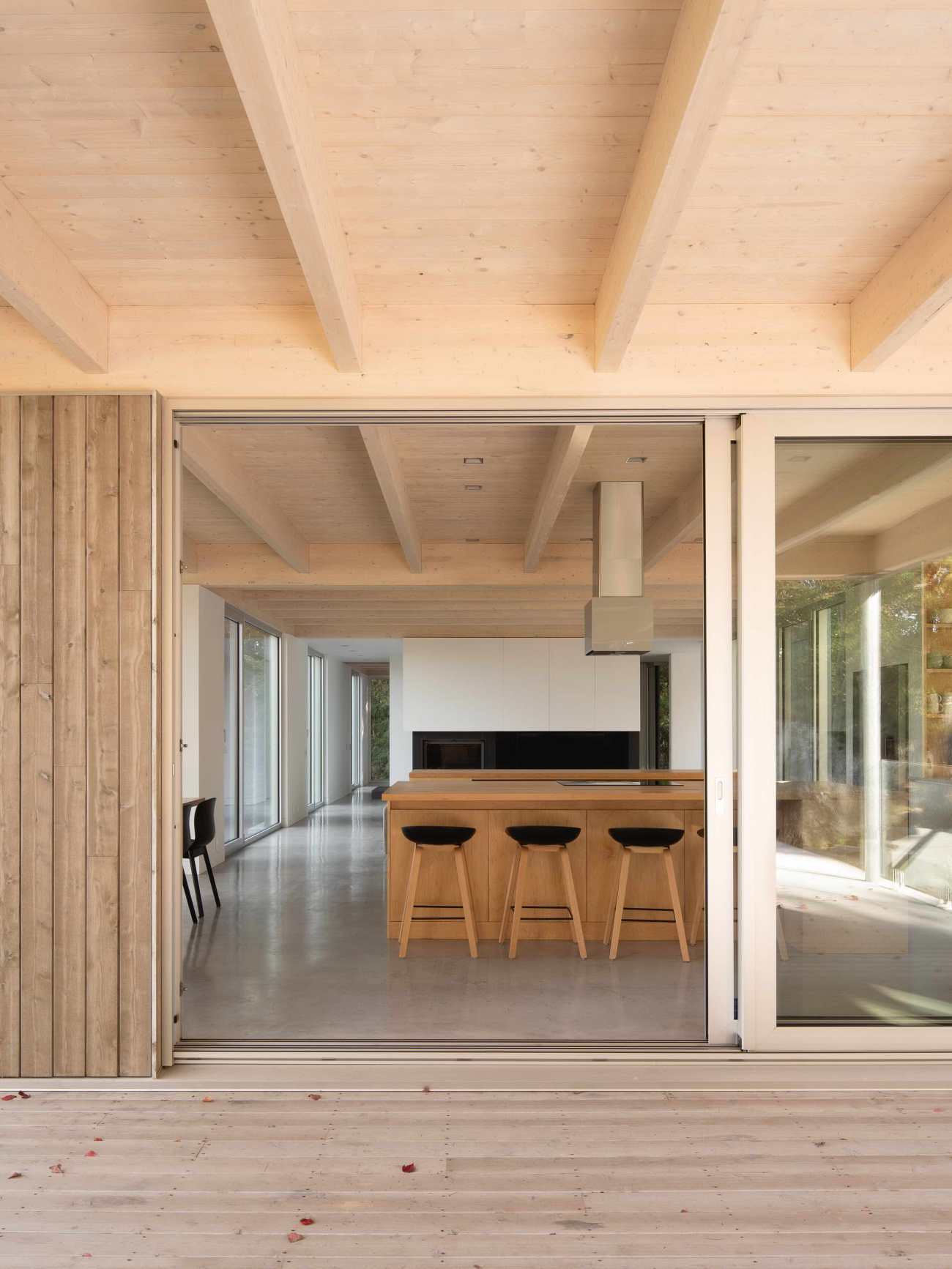 |
厨房的岛、盥洗台、楼梯和走道都使用了实心枫木,而其余的嵌入式橱柜则使用了俄罗斯胶合板。建筑师为室内选择了明亮的色调,与房子周围的黑暗森林形成鲜明的对比。抛光的混凝土地板、石膏墙和天然铝窗与木材和谐地融合在一起,有助于照亮丰富的自然光。
Solid maple was used for the kitchen islands, the vanities the stairs, and the catwalk whereas Russian plywood was used throughout for the rest of the built-in cabinetry. The bright palette chosen by the architects for the interiors contrasts sharply with the, at times, dark forest around the house. Polished concrete floors, gypsum walls, and the natural aluminum windows blend harmoniously with the wood and help brighten the abundant natural light.
平台下面的地基被从外面隔绝,以保留里面粗糙的混凝土,提醒人们注意现在的悬崖边上的岩石。暴露的混凝土与窗外的石块完美地融合在一起,显现了场地的本质。
Below deck, the foundation was insulated from without in order to preserve the rough concrete within, a reminder of the rock that now shores up the edge of the precipice. The exposed concrete blends in perfectly with the outcrops of stone seen just beyond the windows. Such is the nature of shelter and place.
融于自然
诞生于客户与自然环境重新联系的愿望,森林之家I,试图通过将景观融合到住宅的每一个角落和缝隙中,提炼出一个地方的本质。它是目前Natalie Dionne建筑团队正在开发的一系列类似主题住宅中的第一个。森林住宅系列反映了建筑师越来越多的愿望,即促进可再生材料的生态使用。
In communion
Born of a client’s desire to reconnect with the natural environment, Forest House I, attempts to distill the essence of a place by folding the landscape into every nook and cranny of the home. It is the first in a series of similarly themed homes presently being developed by the team at Natalie Dionne Architecture. The Forest Home series reflect the architect’s growing desire to promote the ecological use of renewable materials.
▽主要层平面图 Main floor plan
▽地下层平面图 Basement floor plan
▽剖面图 Section
▽剖面图 Section
Name of the project: Forest House I
Architects: Natalie Dionne Architecture
Location: Bolton-Est, Eastern Townships, QC, Canada
Area of the project: House 2300sq.ft. (215sq.m.) / Terraces 650sq.ft. (60sq.m.)
Project end date: Fall 2020
Design team: Natalie Dionne, Corinne Deleers, Rosemarie Faille-Faubert, and Martin Laneuville
Clients: Martine Bleau and Louis Barrière
Engineer: Latéral
Photographer: Raphaël Thibodeau
更新日期:2020-11-26 16:30:21
非常感谢 Natalie Dionne Architecture 带来的精彩项目, 查阅更多Appreciations towards Natalie Dionne Architecture for sharing wonderful work on hhlloo. Click to see more works!
